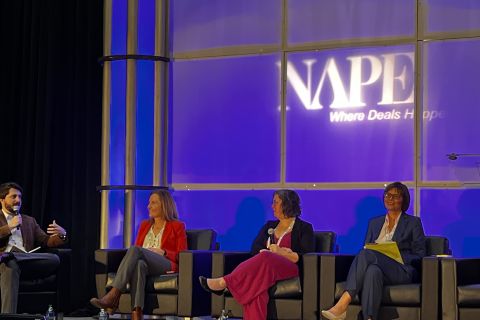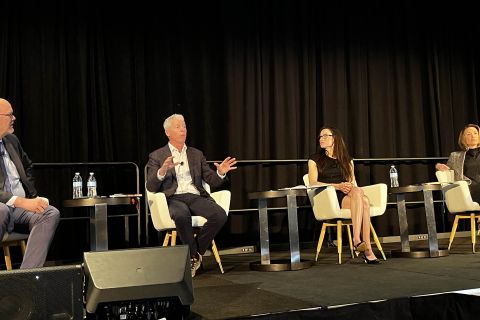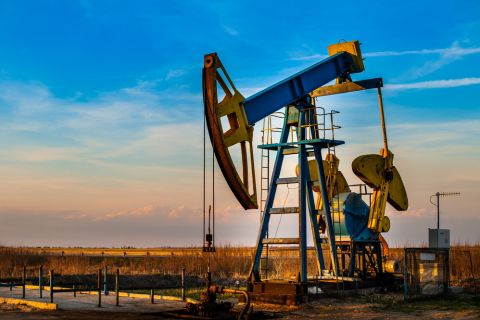There are eight 3-D seismic immersion/visualization labs in Anadarko Petroleum's new 30-story headquarters north of Houston, but president and chief executive officer John Seitz, a veteran explorationist, doesn't get to use them himself, to his regret. The employees, however, keep them occupied about three-fourths of the time. In 2002, the $11-billion-market-cap company focused on generating exploration ideas whose benefits should show up in 2003 and beyond, rather than increasing production. It ratcheted down its operated drilling rig count from the 90s to the mid-30s. Seitz tackles important big-picture considerations, such as how to move the company forward since the megamerger with Union Pacific Resources in 2000. After years of steady reserve and production growth, stock-price appreciation and a premium valuation, production growth slowed in the past year. Last January, it restated third-quarter 2001 numbers to take a noncash, after-tax ceiling test write-down of $1.57 billion for properties in the U.S., Canada and South America. Like most stocks in the E&P sector, it has stumbled a bit relative to historical performance. But NYSE-traded APC is still the most widely held, widely analyzed independent oil-company stock in the world. Analysts applauded third-quarter 2002 results. But due to new debt and the asset impairment, the shares still traded below their traditional multiple. Anadarko boosted its 2002 capital spending by about 10% last summer to $2.5 billion and expects to spend about the same in 2003, but is projecting a higher budget of $2.7 billion by 2004. The majority of the spending increases will take place in the Gulf of Mexico-especially as the company heads for deeper water and acreage it picked up in the controversial eastern Gulf federal sale-and in Canada. The company operated 33 rigs in North America and four internationally during the third quarter. Onshore production in the U.S. and Algeria will be flat in 2003. But Anadarko projects worldwide production growth of 8% in 2003 and 11% in 2004 based on activity in the Gulf, Canada and Qatar, and on the heels of the recent Howell Petroleum Corp. acquisition, which brought Wyoming light-oil reserves. Several projects are coming onstream soon. Most noteworthy is Marco Polo, the company's first deepwater development in the Gulf, which boasts the world's deepest tension-leg platform, in 4,300 feet of water. It begins producing in first-quarter 2004. Seitz, who was promoted to CEO a year ago, discussed the company and the industry with Oil and Gas Investor recently. Investor Why is there less drilling in the U.S., in spite of high commodity prices? Are there fewer good prospects? Seitz I don't have one good answer except that, anecdotally, there is less deal flow. You don't see the volume of prospects you did 20 years ago. For one thing, a lot of the mom-and-pops are retiring-that source is drying up. Those people knew every nook and cranny of an area. I don't know if there isn't enough profit potential for new entrepreneurs or if it's because costs have gone up. A lot of prospects 10 or 15 years ago could be based just on geology, whereas today 3-D seismic and interpretation is often necessary and sometimes costly. Investor You dramatically reduced your domestic program. Is that a temporary change? Seitz We are spending our cash flow. In July 2001, we had 99 company-operated rigs running but the cost of oilfield services continued to climb. As oil and gas prices went down, cash flow was slashed from expectations-we were not hedged at that time. When you ramp up that many rigs, you are running and gunning, and unfortunately, some of the wells can end up being too costly or less than optimum. Now, everything we do is designed to reduce uncertainty. So, we probably are not going back to 99 company-operated rigs. We won't over-react when prices are high or under-react when they are low. I can make that statement because we are hedged. We are hedging around 500 million cubic feet a day or 26% of our gas production for 2003 and 2004. We have 60,000 barrels a day hedged for 2003-about 25% of our oil. Investor Why has your philosophy changed? Seitz We made a decision to hedge for the long-term value. Had we hedged in 2001 for 2002, we would have had several more million dollars of cash flow available to use to deliver production growth. But with our hedges in place now, we've put a floor on the downside-a few hundred million dollars less of cash flow would still allow us to deliver the 2003 and 2004 numbers. In fact. we're more confident about projections because we're hedged. Investor What else has changed? Seitz Our business has become more predictable, but that does come at a cost. Success rates have gone up, but costs have too, when you consider new factors like 3-D seismic and other high-tech things. A discovery used to carry you through maybe 100 dry holes. Today it may carry you through 20. If an independent found a 50- or 100-million-barrel field in Oklahoma, you could run a drilling program for a long time off that. It's more difficult now. Investor Does that mean it's not as much fun anymore? Seitz It's a different kind of fun. It's not wild and crazy dice-rolling, but we take satisfaction in using the technology to deliver what we said we would. Today a young geologist or engineer can come to work here and make a recommendation that could make the company actually commit half a million dollars to see if they are right. We have a lot of young people around here doing the work and we're backing them. Investor Tell me about your recruiting. Seitz Historically we recruited five engineers and five geologists and geophysicists (G&G) per year for the last 18 years. We started maybe 10 years ago to recruit more G&G and that provided us with some fresh ideas and access to the latest technology. Mark Pease, Bob Daniels, Jim Emme: they are executives with us now. They've become the leaders of the company. In 2001, the company hired 30 G&G graduates and 15 in engineering. In 2002, we hired 11 G&G and 11 engineering grads. Investor Does the Howell deal ($265 million for Salt Creek Field in Wyoming) mean it's getting harder for you to find oil in the U.S. Seitz It's a matter of recognizing value and doing the work to capture that value, to do something with it that wasn't being done before. Howell is like making a 50-million-barrel proved discovery. Anadarko has a lot of experience in miscible production, so we looked around the U.S. to see where else we could apply that technology. We'll install the pipeline and begin CO2 injection, and it will become a 150-million-barrel field. And in the future we expect to joint-venture with other companies there, or we can sell the CO2 to them in the Powder River Basin. It was quite a deal. We had to negotiate with three companies: Howell, ExxonMobil (which was venting its huge CO2 source at nearby LaBarge, Wyoming), and Petro Source, which has exclusive rights to market ExxonMobil's CO2. It's exciting because Salt Creek is the largest oil field in Wyoming. Investor What should be your key performance measure going forward-growth or returns? Seitz They are linked. But with a high growth rate you risk damaging your returns; we don't want to sacrifice returns for growth. We have a portfolio of different commodity prices through hedging just as we have a portfolio of wells to drill. Our portfolio has a variety of production profiles and each has its own costs and production decline-some in deep water, some on the Shelf, Algeria, the Bossier in Texas and Louisiana, some Canada, Qatar, etc. Ultimately, you have to have returns better than the cost of capital. When commodity prices and costs give us the opportunity, we'll go back to growth, but within return parameters somewhere above 10%. Investor So, are the days of industry overspending its cash flow gone? Seitz Yes. Unequivocably. Those days were unproductive. We as an industry did not justify the results we generated. I reserve the right to borrow-or sell assets-for say $100- to $300 million, if cash flow drops and we have an attractive development opportunity to fund. But the plan is to spend our cash flow. Investor Do acquisitions still fit in? Seitz Acquisitions are opportunistic but impossible to predict, but our organic growth is possible to predict. An acquisition would be accretive to our internal growth story. The Howell deal will probably be funded out of 2003 cash flow. We see $2.5 billion of cash flow in 2003 and about $500 million of that will be for exploration. We're using $3.85 (for gas) and $24.50 (for oil) as our price deck. We have an understanding of how many rigs it takes to keep U.S. production flat. We think a good long-term price of $3.25 will drive about 730 gas rigs to keep supply flat.
Recommended Reading
CERAWeek: Saudi Aramco CEO Says No Peak in Oil Demand for Some Time to Come
2024-03-18 - Reducing greenhouse gas emissions from hydrocarbons through carbon capture and other technologies achieves better results than alternative energies, Saudi Aramco CEO Amin Nasser said.
NAPE: CCUS is a Risky Venture Hinging on Tech, Regulation, Reservoirs
2024-02-14 - Transdisciplinary collaboration and reservoir understanding are key to mitigating CCUS risks.
Amid Climate Scaremongering, Energy Execs Urge Engagement, Realism
2024-02-06 - From shale boom to net zero goals, industry experts grappled with the contradictions facing the energy industry during SPE’s Hydraulic Fracturing Technology Conference.
RBC: Minerals, E&P Stocks Wooing Back Generalist Investors
2024-04-16 - Public mineral and royalty companies have performed well in the markets, and investors are taking notice. But experts say mineral and royalties stocks still have a long way to go to compete for generalist investor capital.
‘Growth Story’ for Oil: Rice's Kenneth Medlock on Demand Trends
2024-03-05 - Economics drive oil demand, not politics, Rice University’s Kenneth Medlock said during the International Drilling Conference and Exhibition in Galveston.




